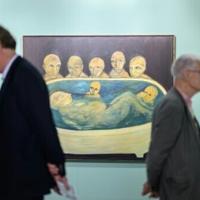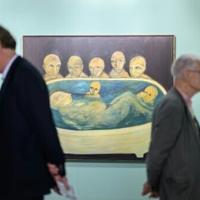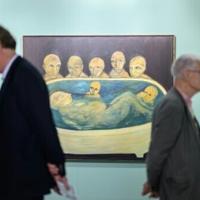Art Market
Monica Jae Yeon Moon
May 8, 2024 7:25PM
Chae Sung-Pil, portrait d/eau (211018), 2021. Courtesy of Cho Jaeyong and Kim Hyunj.
One of the most pertinent themes over recent years in the global art market has been the growth and expansion of the South Korean art world. New art fairs, galleries, and institutions have flowered in the country, fortified by a rich artistic history that is finding new audiences around the world.
The capital city of Seoul—where the Frieze and Kiaf art fairs take place in September—is home to vanguards of modern and contemporary Korean art, such as Kukje, Gallery Hyundai, Arario, and the Art Sonje Center. It’s also where the internationalization of the Korean market becomes apparent: Sandwiched between a myriad of embassies in Hannam are Lehmann Maupin, Pace Gallery, and Thaddaeus Ropac, as well as local galleries such as Foundry Seoul and P21.
On the southeast coast, meanwhile, Busan—one of Artsy’s five emerging art capitals to watch in 2024—will raise the curtain on the 14th edition of Art Busan this week. South Korea’s second most populous city will also host a Biennale in August. Its growth is another sign of the country’s continued art market momentum.
Undergirding the continued strength and growth in the South Korean market are its collectors. As well as a strong base of longstanding family collections, the domestic market has been bolstered by an influx of younger demographics who, by being more communicative and transparent about their acquisitions, are shifting the perception of art collecting in a more inclusive, participatory direction.
Here, we speak to six collectors who are united by their distinct tastes and careful approaches to collecting, sometimes stretching over generations. Whether globe-trotting or hyper-local, they are a testament to the history of collecting in Korea and its promising future.
Cho Jaeyong and Kim Hyunji
Medical practitioners, Daegu
Portrait of Kim Hyunji and Cho Jaeyong. Courtesy of Kim Hyunji and Cho Jaeyong.
Nam Tchun-Mo, Strokelines 21-60, 2021. Courtesy of Kim Hyunji and Cho Jaeyong.
Advertisement
“At the time, I thought they were too expensive and meaningless,” said Cho Jaeyong of the prints by names such as Kim Tschang-Yeul, Park Jong Kyu, and Lim Taek that started the couple’s collecting journey. Cho and his wife, Kim Hyunji, were med school campus sweethearts, and their art collection began with the opening of Kim’s doctor practice: The prints were acquired to spruce up the interior.
Fast forward to 15 years later, and Cho and Kim’s previous home is now an art museum and a lynchpin of the local art scene in the southeast metropolitan city of Daegu, showcasing their eponymous collection that includes works by Lee Ufan, Chung Sang Hwa, Park Seo-Bo, Lee Bul, and Nam June Paik.
For those who think Seoul is all there is to it for art in Korea, Cho and Kim’s collection tells a different story. “Daegu is truly an art city, in that it not only is a home for artists such as Lee In-Sung and Nam Tchun-Mo and galleries such as Leeahn Gallery and Wooson Gallery, but also for generations of collectors who come together to study and enjoy art together, which is rare even overseas,” said Cho.
Doongwok Suh, Moonlight-Charlotte, 2024. Courtesy of Cho Jaeyong and Kim Hyunji.
The local collectors’ group Misu-hoe, for example, has been spearheading collections in Asia by embracing international artists such as Mary Corse and serving as a hub for foreign galleries visiting Korea for the last two decades.
The couple believes that older generations of collectors need to break down barriers to make it easier for emerging collectors to build a presence in the art market, thereby helping it to flourish. “We wanted to give back the generous education we received 15 years ago to the new collectors,” explained Cho.
The couple now looks forward to a continued immersion in contemporary art, and aim to eventually donate their collection to the community. “When young artists are able to fully express their inspirations, emerging galleries are able to work in the direction they set, and young collectors are able to freely establish themselves in the art market, a happier and more fruitful outcome returns to us established collectors,” said Cho.
Nam Jeong-Ho
Attorney, Seoul
Portrait of Nam Jeong-Ho. Courtesy of Nam Jeong-Ho.
Collecting began as part of the job for Nam Jeong-Ho. One of the first legal projects he was involved with as an attorney was monetizing an inventory of artworks. As his work took him to art fairs and auctions, “it became evident that I was bitten by the bug, and I have been collecting since,” he said.
Since then, Nam has come to enjoy works from artists whose evolution resonates with his sensibilities, like that of Jang Jong-Wan, whose work has developed into nuanced narratives. “A new generation of prolific talents forced me to become more prudent and methodical in my acquisition strategies,” said Nam about his recent acquisitions of works by younger artists Keunmin Lee and Eom Yu-Jeong.
These are supplemented by works of in-demand blue-chip artists such as Chung Sang-Hwa and Kim Tschang-Yeul. The fluctuations in the South Korean art market, in his view, are part of the country’s development and growth. “I believe more nuanced and meaningful strategies of collecting will eventually take root in the Korean market as its participants mature,” he noted.
Keunmin Lee, Refining Hallucinations, 2024. Courtesy of Nam Jeong-Ho.
Nam’s acute understanding of Korean history leads to a deep appreciation of the past and present of art in his country. “Korea’s rapid and compressed modernization in the latter half of the 20th century, following a series of atrocities such as Japanese colonization and the Korean War, undeniably imbues a palpable sense of urgency and sadness to works created by artists who depicted a world dynamically and indifferently transforming into an unrecognizable state,” he said. “The neck-breaking speed of Korean modernization caused an intergenerational chasm that remains still difficult to reconcile. This means the younger Korean artists’ perspectives have become fundamentally divergent from those of the older generation…I greatly appreciate and enjoy this broadness of spectrum in the art scene in Korea.”
Teo Yang
Founder of Teo Yang Studio, Seoul
Portrait of Teo Yang. Courtesy of Teo Yan.
Haegue Yang, installtion view of Non-Folding – Geometric Tipping #58, 2015. Courtesy of Teo Yang.
studio is housed in a century-old hanok. Living and working in such a historic area where the changes of the previous centuries are so apparent that “it’s hard not to think about the future,” he defines the theme of his work as “the rediscovery and future of tradition and locality.”
Teo Yang Studio is a commercial and residential design studio. Projects include some of the most prominent spaces representing local history and contemporary encounters with global influences, such as the Gyeongju National Museum, Kukje Gallery, Thaddaeus Ropac Seoul, and last year’s Chanel-sponsored crafts exhibition at Yéol Bukchon-ga, which coincided with Frieze.
Yang’s personal collection ranges from Gaya period earthenware (42–562 BCE) to 20th-century dansaekhwa, or “monochrome painting,” a minimalist genre formulated by a generation of painters who witnessed the trauma of the Korean War. Yang enjoys juxtaposing ancient and contemporary art and imagining future directions. In his studio, the black spray paint of Haegue Yang’s Non-Folding – Geometric Tipping #58 (2015) resembles ink on mulberry paper and opens up to interpretations that transcend time and genre.
Installation view, left to right: Lee Bae, Brushstroke 39; 2020, Elmgreen & Drageset, The Other He, 2018. Courtesy of Teo Yang.
Deeply incorporated into his space of work and life, Yang’s collection provides grounds for self-reflection both as a designer and a person. “Owning something means having a deeper relationship with the object, compared to just viewing,” he said. “Before owning a work, I always try to understand the art and artist, and in this process, I learn new perspectives and knowledge I wasn’t even aware of before.” Because of this, he believes that collectors should be grateful to the artists and their work for changing their perspectives and worldviews. “Collectors should be prepared to share their learnings with others,” he added.
A recent learning for Yang came from Berlin Gallery Week: “The ‘Territory’ exhibition at Sprüth Magers, featuring works of Gala Porras-Kim and Mire Lee, left an impression on me, with its unique aesthetic of uncertainty and peculiar emotion inherent to gallery spaces,” he recalled.
In the future, he imagines having a space to share his collection with a bigger audience, citing the Feuerle Collection at Landwehr Canal and the Boros Collection as inspirations.
Regina and Angela Lee
Art consultant and collection manager, Seoul
Portrait of Regina and Angela Lee. Courtesy of Regina and Angela Lee.
“The art market is a triangle made up of artists, galleries, and collectors; balance is key to a healthy market,” said Angela Lee, who, along with her mother, Regina, supports a myriad of artists and galleries on both a local and global scale.
Their interest in contemporary art, in its truest and global sense, can be observed in the foresight of their collection, from dansaekhwa masterpieces—when they were yet to gain their blue-chip status—to works by Yoshitomo Nara, Sam Gilliam, and George Condo, as well as experimental works by Lee Kun-Yong, Kim Kulim, and Lee Kang-So. The energetic works of Hernan Bas, Nicolas Party, Sharah Hughes, Kim Sun-Woo, and Eddie Kang also make up the mix.
The robust and international family collection was built on the basis of the mother’s and daughter’s expertise and finds its roots in New York. After her college education, Regina moved to the United States to further her studies in advertising design and began building trusted cross-Pacific relationships in the art world. Angela, inspired by her mother from childhood, studied art history and visual arts at Columbia University and went on to work at galleries including Pace Gallery and Tina Kim Gallery before moving to Seoul to work independently.
The global knowledge exchange that grounds the Lee family collection in many ways reflects a wider trend of Korean art professionals acting as cross-cultural bridges, their endeavors often funded by the government and conglomerates such as LG, Samsung, and Hyundai.
The vibrancy that marks out the Lee family collection continues to grow. Recent acquisitions include works by promising artists such as Yuichi Hirako, Ulala Imai, and Xiyao Wang, as well as rediscoveries of Lynne Drexler and Salvo. Angela expresses particular excitement about Lucy Bull, Caroline Walker, and Ann Craven, as well as recent exhibitions of Wangechi Mutu at the New Museum and Pacita Abad at SFMoMA that participate in ongoing discourses on post-colonialism, feminism, environmentalism, and queerness.
Angela envisions future possibilities of transforming the family collection into a gallery or museum—or running an exhibition space to showcase global talents to the audience in Seoul.
Monica Jae Yeon Moon
This post was originally published on this site be sure to check out more of their content



